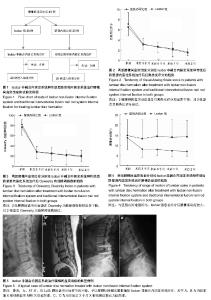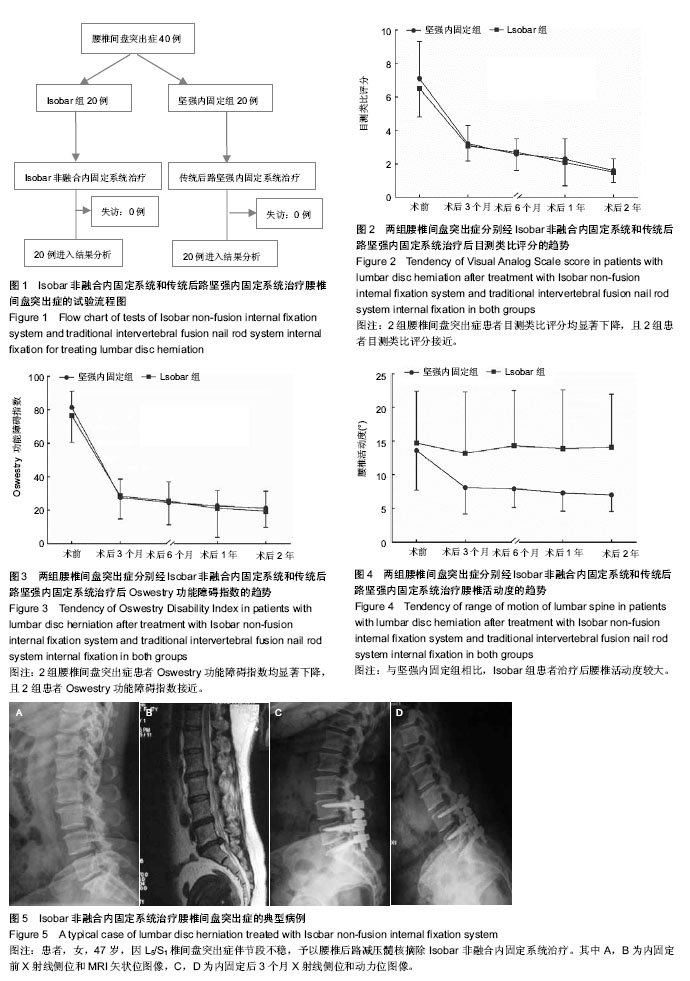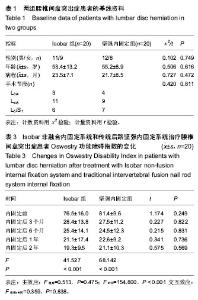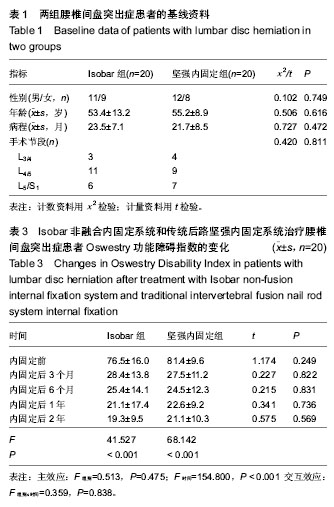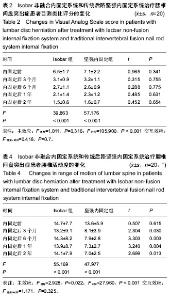Chinese Journal of Tissue Engineering Research ›› 2015, Vol. 19 ›› Issue (13): 2051-2056.doi: 10.3969/j.issn.2095-4344.2015.13.016
Previous Articles Next Articles
Posterior Isobar non-fusion internal fixation system in repair of lumbar disc herniation: more advantages in restoring range of motion of lumbar spine
Liu Yan-bin, Fu Qiang
- Department of Spinal Surgery, Changhai Hospital, Second Military Medical University of Chinese PLA, Shanghai 200433, China
-
Received:2015-02-27Online:2015-03-26Published:2015-03-26 -
Contact:Fu Qiang, Associate chief physician, Associate professor, Department of Spinal Surgery, Changhai Hospital, Second Military Medical University of Chinese PLA, Shanghai 200433, China -
About author:Liu Yan-bin, Studying for master’s degree, Department of Spinal Surgery, Changhai Hospital, Second Military Medical University of Chinese PLA, Shanghai 200433, China
CLC Number:
Cite this article
Liu Yan-bin, Fu Qiang . Posterior Isobar non-fusion internal fixation system in repair of lumbar disc herniation: more advantages in restoring range of motion of lumbar spine[J]. Chinese Journal of Tissue Engineering Research, 2015, 19(13): 2051-2056.
share this article
| [1] Hasankhani EG, Omidi-Kashani F. Posterior tension band wiring and instrumentation for thoracolumbar flexion-distraction injuries. J Orthop Surg (Hong Kong). 2014;22(1):88-91. [2] Kwon YK, Jang JH, Lee CD, et al. Fracture of the L-4 vertebral body after use of a stand-alone interbody fusion device in degenerative spondylolisthesis for anterior L3-4 fixation. J Neurosurg Spine. 2014;20(6):653-656. [3] Lequin MB, Verbaan D, Bouma GJ. Posterior lumbar interbody fusion with stand-alone Trabecular Metal cages for repeatedly recurrent lumbar disc herniation and back pain. J Neurosurg Spine. 2014;20(6):617-622. [4] Wang ST, Ma HL, Liu CL, et al. Is fusion necessary for surgically treated burst fractures of the thoracolumbar and lumbar spine?: a prospective, randomized study. Spine (Phila Pa 1976). 2006; 31(23):2646-2652; discussion 2653. [5] Upasani VV, Farnsworth CL, Tomlinson T, et al. Pedicle screw surface coatings improve fixation in nonfusion spinal constructs. Spine (Phila Pa 1976). 2009;34(4):335-343. [6] Chin KR, Boselli K, Cairone S. Lag screw fixation of remote bilateral pedicle fractures of the fourth and fifth lumbar vertebrae after a single gunshot wound: a case report and technical pearl. Spine J. 2010;10(2):136-140. [7] Tezeren G, Bulut O, Tukenmez M, et al. Long segment instrumentation of thoracolumbar burst fracture: fusion versus nonfusion. J Back Musculoskelet Rehabil. 2009;22(2):107-112. [8] Marino JF. Nonfusion short fixation of A3 burst fractures, loss of fixation attributable to polyaxial screw slippage? Spine J. 2010; 10(5):459-460; author reply 460. [9] Zhang JD, Poffyn B, Sys G, et al. Are stand-alone cages sufficient for anterior lumbar interbody fusion? Orthop Surg. 2012;4(1):11-14. [10] Mieritz RM, Bronfort G, Hartvigsen J. Regional lumbar motion and patient-rated outcomes: a secondary analysis of data from a randomized clinical trial. J Manipulative Physiol Ther. 2014; 37(9):628-640. [11] Bydon M, Macki M, Abt NB, et al. The cost-effectiveness of interbody fusions versus posterolateral fusions in 137 patients with lumbar spondylolisthesis. Spine J. 2015;15(3):492-498. [12] Ellingson AM, Nuckley DJ. Altered helical axis patterns of the lumbar spine indicate increased instability with disc degeneration. J Biomech. 2015;48(2):361-369. [13] Holsgrove TP, Gill HS, Miles AW, et al. The dynamic, six-axis stiffness matrix testing of porcine spinal specimens. Spine J. 2015;15(1):176-184. [14] Tian NF, Wu YS, Zhang XL, et al. Fusion versus nonfusion for surgically treated thoracolumbar burst fractures: a meta-analysis. PLoS One. 2013;8(5):e63995. [15] Stemper BD, Baisden JL, Yoganandan N, et al. Mechanical yield of the lumbar annulus: a possible contributor to instability: Laboratory investigation. J Neurosurg Spine. 2014; 21(4):608-613. [16] Baaj AA, Gantwerker BR, Theodore N, er al. Radiographic assessment of thoracolumbar fractures based on axial zones. J Spinal Disord Tech. 2014;27(2):59-63. [17] Tsitsopoulos PP, Serhan H, Voronov LI, et al. Would an anatomically shaped lumbar interbody cage provide better stability? An in vitro cadaveric biomechanical evaluation. J Spinal Disord Tech. 2012;25(8):E240-244. [18] Pestka JM, Seitz S, Zustin J, et al. Paget disease of the spine: an evaluation of 101 patients with a histomorphometric analysis of 29 cases. Eur Spine J. 2012;21(5):999-1006. [19] Cook DJ, Yeager MS, Cheng BC. Interpedicular travel in the evaluation of spinal implants: an application in posterior dynamic stabilization. Spine (Phila Pa 1976). 2012;37(11):923-931. [20] Inoue N, Espinoza Orías AA. Biomechanics of intervertebral disk degeneration. Orthop Clin North Am. 2011;42(4):487-499, vii. [21] Prasad KS, Gregson BA, Hargreaves G, et al. Inversion therapy in patients with pure single level lumbar discogenic disease: a pilot randomized trial. Disabil Rehabil. 2012;34(17):1473-1480. [22] Kumar N, Kumar A, Siddharth MS, et al. Annulo-nucleoplasty using Disc-FX in the management of lumbar disc pathology: Early results. Int J Spine Surg. 2014;8:1-13. [23] Rudolf L, Capobianco R2. Five-year clinical and radiographic outcomes after minimally invasive sacroiliac joint fusion using triangular implants. Open Orthop J. 2014;8:375-383. [24] Mobbs RJ, Maharaj M, Rao PJ. Clinical outcomes and fusion rates following anterior lumbar interbody fusion with bone graft substitute i-FACTOR, an anorganic bone matrix/P-15 composite. J Neurosurg Spine. 2014;21(6):867-876. [25] Maleci A, Sambale RD, Schiavone M, et al. Nonfusion stabilization of the degenerative lumbar spine. J Neurosurg Spine. 2011;15(2):151-158. [26] Sears WR, Sergides IG, Kazemi N, et al. Incidence and prevalence of surgery at segments adjacent to a previous posterior lumbar arthrodesis. Spine J. 2011;11(1):11-20. [27] Kim YM, Kim DS, Choi ES, et al. Nonfusion method in thoracolumbar and lumbar spinal fractures. Spine (Phila Pa 1976). 2011;36(2):170-176. [28] Di Silvestre M, Lolli F, Bakaloudis G, et al. Dynamic stabilization for degenerative lumbar scoliosis in elderly patients. Spine (Phila Pa 1976). 2010;35(2):227-234. [29] Ding F, Jia Z, Wu Y, et al. Fusion-nonfusion hybrid construct versus anterior cervical hybrid decompression and fusion: a comparative study for 3-level cervical degenerative disc diseases. Spine (Phila Pa 1976). 2014;39(23):1934-1942. [30] Lee SE, Jahng TA, Kim HJ. Decompression and nonfusion dynamic stabilization for spinal stenosis with degenerative lumbar scoliosis: Clinical article. J Neurosurg Spine. 2014; 21(4):585-594. [31] Mayer TG, Gatchel RJ, Brede E, et al. Lumbar surgery in work-related chronic low back pain: can a continuum of care enhance outcomes? Spine J. 2014;14(2):263-273. [32] Zhang L, Shu X, Duan Y, et al. Effectiveness of ISOBAR TTL semi-rigid dynamic stabilization system in treatment of lumbar degenerative disease. Zhongguo Xiu Fu Chong Jian Wai Ke Za Zhi. 2012;26(9):1066-1070. [33] Hrabálek L, Wanek T, Adamus M. Treatment of degenerative spondylolisthesis of the lumbosacral spine by decompression and dynamic transpedicular stabilisation. Acta Chir Orthop Traumatol Cech. 2011;78(5):431-436. [34] Li Z, Li F, Yu S, et al. Two-year follow-up results of the Isobar TTL Semi-Rigid Rod System for the treatment of lumbar degenerative disease. J Clin Neurosci. 2013;20(3):394-399. [35] Barrey C, Perrin G, Champain S. Pedicle-Screw-Based Dynamic Systems and Degenerative Lumbar Diseases: Biomechanical and Clinical Experiences of Dynamic Fusion with Isobar TTL. ISRN Orthop. 2013;2013:183702. [36] Chamoli U, Diwan AD, Tsafnat N. Pedicle screw-based posterior dynamic stabilizers for degenerative spine: in vitro biomechanical testing and clinical outcomes. J Biomed Mater Res A. 2013. in press. [37] Chamoli U, Diwan AD, Tsafnat N. Pedicle screw-based posterior dynamic stabilizers for degenerative spine: in vitro biomechanical testing and clinical outcomes. J Biomed Mater Res A. 2014;102(9):3324-3340. [38] Gao J, Zhao W, Zhang X, et al. MRI analysis of the ISOBAR TTL internal fixation system for the dynamic fixation of intervertebral discs: a comparison with rigid internal fixation. J Orthop Surg Res. 2014;9:43. [39] 徐海栋,付强.后路Isobar非融合内固定系统治疗腰椎退行性疾病疗效分析[J].中国矫形外科杂志,2013,21(11):1149-1152. [40] Barz T, Lange J, Melloh M, et al. Histomorphometric and radiographical changes after lumbar implantation of the PEEK nonfusion interspinous device in the BB.4S rat model. Spine (Phila Pa 1976). 2013;38(5):E263-269. [41] Jiang SD, Chen JW, Jiang LS. Which procedure is better for lumbar interbody fusion: anterior lumbar interbody fusion or transforaminal lumbar interbody fusion? Arch Orthop Trauma Surg. 2012;132(9):1259-1266. [42] Tuli SM, Kapoor V, Jain AK, et al. Spinaplasty following lumbar laminectomy for multilevel lumbar spinal stenosis to prevent iatrogenic instability. Indian J Orthop. 2011;45(5):396-403. |
| [1] | Song Chengjie, Chang Hengrui, Shi Mingxin, Meng Xianzhong. Research progress in biomechanical stability of lateral lumbar interbody fusion [J]. Chinese Journal of Tissue Engineering Research, 2021, 25(6): 923-928. |
| [2] | Tang Xiaokai, Li Weiming. Role and mechanism of Nel-like molecule-1 in promoting bone fusion after spinal fusion [J]. Chinese Journal of Tissue Engineering Research, 2021, 25(24): 3914-3920. |
| [3] | Yang Qin, Zhou Honghai, Chen Longhao, Zhong Zhong, Xu Yigao, Huang Zhaozhi. Research status and development trend of pelvic reconstruction techniques: a bibliometric and visual analysis [J]. Chinese Journal of Tissue Engineering Research, 2021, 25(23): 3718-3724. |
| [4] | Zhao Hongshun, A Jiancuo, Wang Deyuan, Xu Zhihua, Gao Shunhong. Factors affecting the height of early intervertebral space after lumbar interbody fusion via lateral approach [J]. Chinese Journal of Tissue Engineering Research, 2021, 25(21): 3332-3336. |
| [5] | Zhang Chongfeng, Li Xianlin, Peng Weibing, Jia Hongsheng, Cai Lei. Treating lumbar disc herniation of blood stasis type with Chinese herbs, acupuncture, moxibustion, and massage: a Bayesian network Meta-analysis [J]. Chinese Journal of Tissue Engineering Research, 2021, 25(17): 2781-2788. |
| [6] | Chen Jiang, Li Jinyu, Zheng Chenying, Bai Chunxiao, Zhang Fan, Liu Chuyin, Zhao Xueqian, Yuan Qiaomei, Di Xueshi, Kang Shengqian, Jia Yusong . Changes in sagittal parameters of cervical spine after double-segment artificial cervical disc replacement and anterior cervical discectomy and fusion [J]. Chinese Journal of Tissue Engineering Research, 2021, 25(15): 2341-2346. |
| [7] |
Zhang Cong, Zhao Yan, Du Xiaoyu, Du Xinrui, Pang Tingjuan, Fu Yining, Zhang Hao, Zhang Buzhou, Li Xiaohe, Wang Lidong.
Biomechanical analysis of the lumbar spine and pelvis in adolescent
idiopathic scoliosis with lumbar major curve |
| [8] | Tuerhongjiang·Abuduresiti, Meng Xiangyu, Maihemuti·Yakufu, Wang Tiantang, Xieraili·Maimaiti, Dai Jifang, Wang Wei. Biomechanical advantages of percutaneous endoscopic lumbar discectomy for lumbar disc herniation [J]. Chinese Journal of Tissue Engineering Research, 2020, 24(36): 5768-5773. |
| [9] | Wang Jing, Xu Shuai, Liu Haiying. Hidden blood loss during posterior lumbar interbody fusion in lumbar spinal stenosis patients with and without rheumatoid arthritis [J]. Chinese Journal of Tissue Engineering Research, 2020, 24(33): 5307-5314. |
| [10] | Cao Liangliang, Xu Jianguang, Mei Wei. Three-dimensional finite element analysis of the biomechanical changes of the lumbar spine after the combination of intervertebral fusion with dynamic internal fixation of the interspinous process in the lumbosacral region [J]. Chinese Journal of Tissue Engineering Research, 2020, 24(12): 1905-1910. |
| [11] |
Wen Yi, Su Feng, Liu Su, Zong Zhiguo, Zhang Xin, Ma Pengpeng, Li Yuexuan, Li Rui, Zhang Zhimin.
Establishment of finite element model of L4-5 and mechanical analysis of degenerative intervertebral discs
|
| [12] | Tian Jie, Ru Jiangying. Preservation of the spinous process ligament complex in expanded decompression of lumbar spinal canal: advantages and disadvantages [J]. Chinese Journal of Tissue Engineering Research, 2019, 23(8): 1228-1234. |
| [13] | Wang Liang, Li Lijun, Zhu Fuliang, Jiang Zhuyan, Wang Shuai, Ni Dongkui . Cortical bone trajectory screw versus pedicle screw fixation after posterior lumbar interbody fusion: a meta-analysis [J]. Chinese Journal of Tissue Engineering Research, 2019, 23(8): 1291-1298. |
| [14] | Zhou Yu, Liu Yuehong, Liu Shuping, Chen Xi, Qin Wei, Li Qifeng. Spinal stability of intervertebral grafting reinforced by five or six augmenting screws versus transvertebral grafting reinforced by four augmenting screws for thoracolumbar vertebral fractures [J]. Chinese Journal of Tissue Engineering Research, 2019, 23(4): 505-511. |
| [15] | Li Qingsong, Liu Shaoyu, Yin Zongsheng. Multiple posterior lumbar interbody fusion and posterolateral fusion instrumentation for thoracolumbar kyphosis and osteoporotic fracture in older adults [J]. Chinese Journal of Tissue Engineering Research, 2019, 23(4): 512-517. |
| Viewed | ||||||
|
Full text |
|
|||||
|
Abstract |
|
|||||
